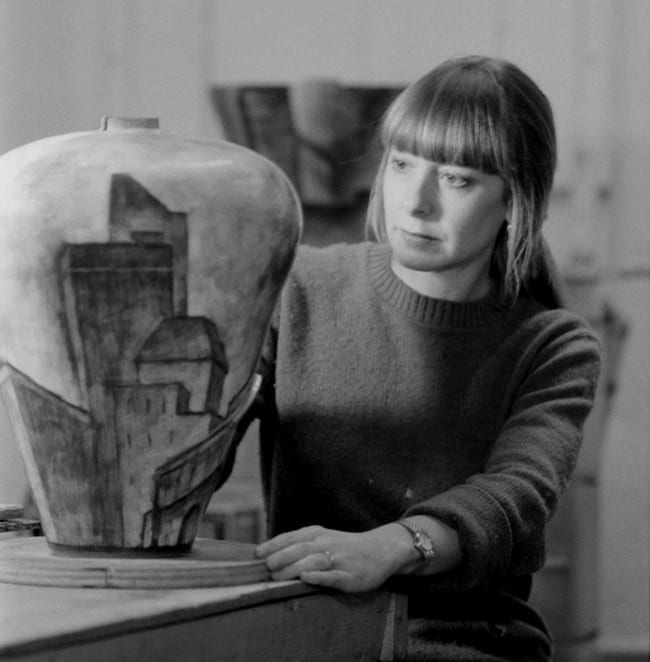Lidya Buzio, artist, sculptor, and ceramist, died of cancer on Sept. 30, 2014 at her home in Greenport, Long Island, at age 65.
Above image: Lidya Buzio.
Buzio’s work was widely acclaimed in the ceramics field and was seen in major exhibitions in museums across the country and internationally. Inspired by the buildings and skyline of lower Manhattan, her most noted ceramic vessels – combining cylinders, cones, and hemispheres – twist and juxtapose the rooflines, architectural details, and water towers of the city into a magical panorama that captures the urban scene while retaining a surreal quality. Her works are unique in the ceramic medium, fusing painting and sculpture with the red clay substratum with a masterful touch.
Critic Ed Lebow once wrote the volume of the painted buildings and how they fit and moved within her pots gave the sensation of breathing.
Of his impression the first time he saw a Lidya Buzio piece, Garth Clark (“The House at 5510” in Lidya Buzio Ceramics, Cecilia de Torres, Ltd. 2012 ) wrote:
“Magical unity; form, color and material that are all one. The imagery of downtown Manhattan hugged the vessel’s sensual curving shape and disappeared and reemerged from its volume, a constant kinetic shifting inwards and outwards. It had a quality of being both ancient and contemporary at the same time.”
Robert C. Morgan (Lidya Buzio, American Ceramics, Vol.15 No. 1, 2006) wrote:
“The effect offered by Buzio, whether in clay or wood, is an illusory one, a magical feast, a post structural ensemble of playful extruded forms. The illusion of these shapes, colors and linear patterns accumulates, after a stealthy period of euphoric contemplation, into something replete with innuendo, obstreperously shifting in scale and proportion. These ironic architectonic deconstructions resemble a psychic phenomenon, the kind that one may feel in those congested screen sets from The Cabinet of Dr. Caligari. Whatever the phenomenon-whether psychic or aesthetic-Buzio has done it. Her glazed and burnished ceramic spectacles are so carefully calculated that the intuition appears hidden until it suddenly bursts forth.”
Born in Uruguay, in 1948, she studied with artists of the Taller Torres-García in Montevideo. Buzio moved to New York City in 1971. Early in the 1990s, she moved to the North Fork of Long Island where she incorporated the rural land and seascape into her work. She had great charm despite her shyness which hid a steely professionalism and determination.
Buzio’s ceramics are in the Brooklyn Museum, Museum of Fine Arts Houston, the Smithsonian National Museum of American Art in Washington, Los Angeles County Museum of Art, the Fine Arts Museum of San Francisco, Nelson-Atkins Museum in Kansas City, Everson Museum in Syracuse, the Victoria & Albert in London, the National Museum Taiwan, Victoria and Albert Museum, London and many other museums and private collections.
Here final exhibition was a large and masterful show with Cecilia Torres Gallery, New York in 2012.
Any thoughts about this post? Share yours in the comment box below.

One of Lidya Buzio’s skyline works.

What breathtaking work! May she rest in peace. I feel sad to only now just see and appreciate her amazing work. She lives on through it.
Lidya was a wonderful and dedicated artist who I’m reminded of on a daily basis, since I’m fortunate enough to have a number of her magical works in my home. She was also an extraordinary person who I was lucky enough to count as a friend. She will certainly be missed, both as an artist and a human being.
It’s around 1979 or so. I’m walking thru the WBAI Craft Fair at Columbia. Remember the day of craft fairs where you could actually find important emerging work? Rounded a corner and there tucked beneath a staircase was Lidia’s “booth”. WOW
Her work is singular. She was a great talent. She will be missed.
Lidya Buzio’s work is personal and timeless, she will be missed.